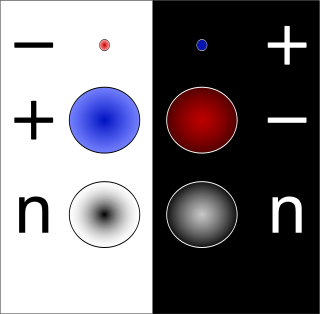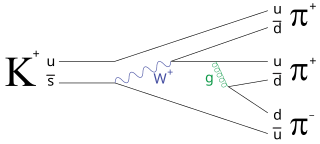Related Research Articles

In particle physics, every type of particle is associated with an antiparticle with the same mass but with opposite physical charges. For example, the antiparticle of the electron is the positron. While the electron has a negative electric charge, the positron has a positive electric charge, and is produced naturally in certain types of radioactive decay. The opposite is also true: the antiparticle of the positron is the electron.

In particle physics, an elementary particle or fundamental particle is a subatomic particle that is not composed of other particles. The Standard Model presently recognizes seventeen distinct particles—twelve fermions and five bosons. As a consequence of flavor and color combinations and antimatter, the fermions and bosons are known to have 48 and 13 variations, respectively. Among the 61 elementary particles embraced by the Standard Model number: electrons and other leptons, quarks, and the fundamental bosons. Subatomic particles such as protons or neutrons, which contain two or more elementary particles, are known as composite particles.

In particle physics, a fermion is a particle that follows Fermi–Dirac statistics. Generally, it has a half-odd-integer spin: spin 1/2, spin 3/2, etc. These particles obey the Pauli exclusion principle. Fermions include all quarks and leptons and all composite particles made of an odd number of these, such as all baryons and many atoms and nuclei. Fermions differ from bosons, which obey Bose–Einstein statistics.

Particle physics or high-energy physics is the study of fundamental particles and forces that constitute matter and radiation. The field also studies combinations of elementary particles up to the scale of protons and neutrons, while the study of combination of protons and neutrons is called nuclear physics.

In nuclear physics and particle physics, the weak interaction, which is also often called the weak force or weak nuclear force, is one of the four known fundamental interactions, with the others being electromagnetism, the strong interaction, and gravitation. It is the mechanism of interaction between subatomic particles that is responsible for the radioactive decay of atoms: The weak interaction participates in nuclear fission and nuclear fusion. The theory describing its behaviour and effects is sometimes called quantum flavourdynamics (QFD); however, the term QFD is rarely used, because the weak force is better understood by electroweak theory (EWT).

The Standard Model of particle physics is the theory describing three of the four known fundamental forces in the universe and classifying all known elementary particles. It was developed in stages throughout the latter half of the 20th century, through the work of many scientists worldwide, with the current formulation being finalized in the mid-1970s upon experimental confirmation of the existence of quarks. Since then, proof of the top quark (1995), the tau neutrino (2000), and the Higgs boson (2012) have added further credence to the Standard Model. In addition, the Standard Model has predicted various properties of weak neutral currents and the W and Z bosons with great accuracy.

In particle physics, a lepton is an elementary particle of half-integer spin that does not undergo strong interactions. Two main classes of leptons exist: charged leptons, and neutral leptons. Charged leptons can combine with other particles to form various composite particles such as atoms and positronium, while neutrinos rarely interact with anything, and are consequently rarely observed. The best known of all leptons is the electron.

In physics, a subatomic particle is a particle smaller than an atom. According to the Standard Model of particle physics, a subatomic particle can be either a composite particle, which is composed of other particles, or an elementary particle, which is not composed of other particles. Particle physics and nuclear physics study these particles and how they interact. Most force carrying particles like photons or gluons are called bosons and, although they have discrete quanta of energy, do not have rest mass or discrete diameters and are unlike the former particles that have rest mass and cannot overlap or combine which are called fermions.
In supersymmetry, the neutralino is a hypothetical particle. In the Minimal Supersymmetric Standard Model (MSSM), a popular model of realization of supersymmetry at a low energy, there are four neutralinos that are fermions and are electrically neutral, the lightest of which is stable in an R-parity conserved scenario of MSSM. They are typically labeled
N͂0
1,
N͂0
2,
N͂0
3 and
N͂0
4 although sometimes is also used when is used to refer to charginos.

In particle physics, annihilation is the process that occurs when a subatomic particle collides with its respective antiparticle to produce other particles, such as an electron colliding with a positron to produce two photons. The total energy and momentum of the initial pair are conserved in the process and distributed among a set of other particles in the final state. Antiparticles have exactly opposite additive quantum numbers from particles, so the sums of all quantum numbers of such an original pair are zero. Hence, any set of particles may be produced whose total quantum numbers are also zero as long as conservation of energy, conservation of momentum, and conservation of spin are obeyed.

In particle physics, a kaon, also called a K meson and denoted
K
, is any of a group of four mesons distinguished by a quantum number called strangeness. In the quark model they are understood to be bound states of a strange quark and an up or down antiquark.
In particle physics, the W and Z bosons are vector bosons that are together known as the weak bosons or more generally as the intermediate vector bosons. These elementary particles mediate the weak interaction; the respective symbols are
W+
,
W−
, and
Z0
. The
W±
bosons have either a positive or negative electric charge of 1 elementary charge and are each other's antiparticles. The
Z0
boson is electrically neutral and is its own antiparticle. The three particles each have a spin of 1. The
W±
bosons have a magnetic moment, but the
Z0
has none. All three of these particles are very short-lived, with a half-life of about 3×10−25 s. Their experimental discovery was pivotal in establishing what is now called the Standard Model of particle physics.
In particle physics, weak isospin is a quantum number relating to the electrically charged part of the weak interaction: Particles with half-integer weak isospin can interact with the
W±
bosons; particles with zero weak isospin do not. Weak isospin is a construct parallel to the idea of isospin under the strong interaction. Weak isospin is usually given the symbol T or I, with the third component written as T3 or I3. It can be understood as the eigenvalue of a charge operator.

This article describes the mathematics of the Standard Model of particle physics, a gauge quantum field theory containing the internal symmetries of the unitary product group SU(3) × SU(2) × U(1). The theory is commonly viewed as describing the fundamental set of particles – the leptons, quarks, gauge bosons and the Higgs boson.
Sterile neutrinos are hypothetical particles that are believed to interact only via gravity and not via any of the other fundamental interactions of the Standard Model. The term sterile neutrino is used to distinguish them from the known, ordinary active neutrinos in the Standard Model, which carry an isospin charge of ±+1/ 2 and engage in the weak interaction. The term typically refers to neutrinos with right-handed chirality, which may be inserted into the Standard Model. Particles that possess the quantum numbers of sterile neutrinos and masses great enough such that they do not interfere with the current theory of Big Bang nucleosynthesis are often called neutral heavy leptons (NHLs) or heavy neutral leptons (HNLs).

A Majorana fermion, also referred to as a Majorana particle, is a fermion that is its own antiparticle. They were hypothesised by Ettore Majorana in 1937. The term is sometimes used in opposition to a Dirac fermion, which describes fermions that are not their own antiparticles.

In classical physics and general chemistry, matter is any substance that has mass and takes up space by having volume. All everyday objects that can be touched are ultimately composed of atoms, which are made up of interacting subatomic particles, and in everyday as well as scientific usage, matter generally includes atoms and anything made up of them, and any particles that act as if they have both rest mass and volume. However it does not include massless particles such as photons, or other energy phenomena or waves such as light or heat. Matter exists in various states. These include classical everyday phases such as solid, liquid, and gas – for example water exists as ice, liquid water, and gaseous steam – but other states are possible, including plasma, Bose–Einstein condensates, fermionic condensates, and quark–gluon plasma.
In nuclear physics and atomic physics, weak charge refers to the Standard Model weak interaction coupling of a particle to the Z boson. For example, for any given nuclear isotope, the total weak charge is approximately −0.99 per neutron, and +0.07 per proton. It also shows an effect of parity violation during electron scattering.

The idea that matter consists of smaller particles and that there exists a limited number of sorts of primary, smallest particles in nature has existed in natural philosophy at least since the 6th century BC. Such ideas gained physical credibility beginning in the 19th century, but the concept of "elementary particle" underwent some changes in its meaning: notably, modern physics no longer deems elementary particles indestructible. Even elementary particles can decay or collide destructively; they can cease to exist and create (other) particles in result.
References
- ↑ Walker, D.C. (1983). Muon and Muonium Chemistry. Cambridge University Press. p. 5. ISBN 978-0-521-24241-7 . Retrieved 23 June 2020.